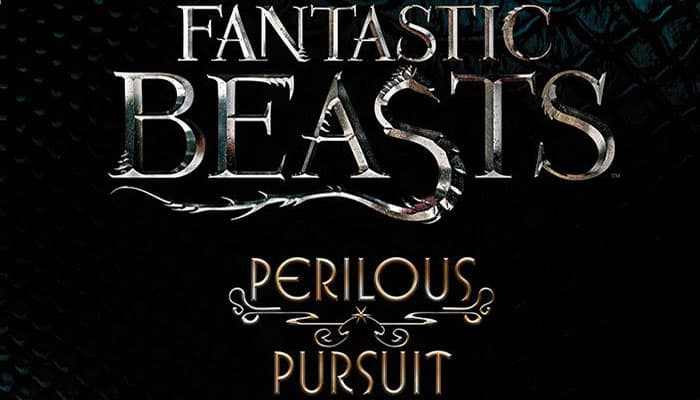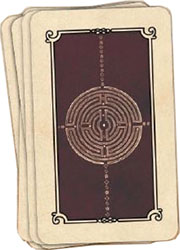
Components

- 4 Player Boards with 15 matching pieces each
- 4 Sliders to snap on the Player Boards
- 1 Beast Movement Token
- 12 Beast Cards
- 6 Dice
- 30 Insight Cards
- Instructions
Object of the Game
Once again, Newt Scamander's magical beasts have escaped and are running loose in New York City. Players must work together to recapture and return 5 of Newt's beasts to his suitcase before they draw the attention of the non-magical community.
The players will lose the game if they let too many beasts escape or, if any of the players become stunned by a beast.
Setup
 A sample set up for a 4 person game. |
Each player selects a character and takes the matching Player Board, Set and Ready Tokens, Shields, and 1 Health Slider. Sort the pieces, and place the Health Slider on the side of the player board with the arrow pointing to the 10.


Shuffle the deck of Insight Cards, deal one to each player, and place them to one side of the Beast Cards in the center of the playing space.
Separate the Beast Cards by their difficulty level (indicated on the back), and randomly choose 5:
- One Level 1 Beast
- One Level 2 Beast
- Three Level 3 Beasts
Place the beasts in a face-up pile in the center of the playing space with the Level 1 Beast on top, with the Level 2 Beast behind it, and the three Level 3 Beasts on the bottom.
Adjusting the difficulty:
- For a harder game add an additional Level 3 Beast to the bottom of the stack.
- For an easier game choose two Level 2 Beasts and only two Level 3 Beasts.
Beast Cards

Each Beast Card features a unique capture track. All players must work together to move the Beast Marker from its' circular starting space into the suitcase. However, the beast will take actions that can cause it to retreat and eventually escape.
Player Boards

Actions
-

Protect: Add 1 Shield Token to the Player Board. A Shield Token can be removed from a player board to prevent a single point of Health damage to the player.
-

Capture 1: This moves the Beast Marker 1 space closer to Newt's suitcase.
-

Distract: Remove 1 die from the beast's dice pool for their turn. The A removed die must be the one in the Action Space.
-

Insight: Draw a card. A player may hold up to three cards. If a player draws a fourth card they must discard one card of their choice.
-

Capture 3: This moves the Beast Marker 3 spaces closer to Newt's suitcase.
-

Wild: This symbol can be used for any of the above actions.
It is only found on the black dice.
-


Beast Reaction: Beasts will react differently. Look at the top of the Beast Card to see what each beast does. This symbol must be resolved immediately when rolled. It is only found on the teal die.
Insight Cards

There are two different types of Insight Cards: cards with dice symbols and cards with text (Action Cards).
-
Insight Cards with dice symbols on them can be used during the Assign Dice phase as additional dice. These cards can be used to complete sets and to place markers on a Player Board.
Additionally, other players can play dice face cards during this phase to help the active player complete their board.
Cards with the x2 under the symbol are worth two dice, but they must be assigned to the same player's board.
-
Action Cards can be played by any player, at any time! Use them to reroll the dice, to keep the beast from rolling as many dice, or to ignore a
 . If the Ignore a
. If the Ignore a  Card is played when the beast rolls, none of the players will have to suffer the effect.
Card is played when the beast rolls, none of the players will have to suffer the effect.
Game Play
Beasts are captured through the use of the six dice. On a player's turn, they will roll dice and assign them to their Player Board, and in some cases on their companions' player boards.
A turn consists of four phases:
- Roll dice
- Assign dice
- Activate dice
- Beast reaction
1. Roll Dice

On their turn, each player will roll the 6 dice up to 3 times.
After each roll the active player may set aside any number of dice, and reroll the others.
A player may change their mind about which dice to set aside after each roll; however, after the 3rd roll they must keep and attempt to use the symbols shown on the dice.
2. Assign Dice
Once the ROLL DICE phase is over, the player must decide which abilities on their Player Board they wish to use, and assign their dice accordingly.
In order to use an action a player must first Ready the action by filling the bottom space for that action, and then Set it by filling the top space with a frame.
To Ready an action a player must assign the indicated set of dice symbols to the bottom space. These dice must all be assigned at one time. Place the matching Ready Token into the bottom space to remind you the action is Ready.
To Set an action, a player must assign one die to the top space, and place the Set Token frame in place as a reminder it has been Set.

Activate

To Activate an action, a player must assign a single die with the indicated symbol, to the space created by the Set token. Dice can be placed in the Activate space on either the same turn the Set token was placed or on a future turn.
In addition, once a player has Set an action, that player may assign dice of that type (or a Wild) to other players' boards that also have that action Set.
Sometimes it will be advantageous for the active player to choose to forgo placing a die on their own board.
This is especially true if another player is low on health and could benefit from an extra shield, or if the active player already has three cards.

Example: On his previous turn, Jacob rolled 3  and Readied his Protect action. On his current turn, he rolls 3 more
and Readied his Protect action. On his current turn, he rolls 3 more  . He uses 1
. He uses 1  to Set his Protect action.
to Set his Protect action.
He can then assign the second  to his own Player Board to take the Protect action. Jacob then sees that Queenie has also Readied and Set her Protect action; so, he assigns the last remaining
to his own Player Board to take the Protect action. Jacob then sees that Queenie has also Readied and Set her Protect action; so, he assigns the last remaining  die to the Protect r action space on Queenie's Player Board.
die to the Protect r action space on Queenie's Player Board.
3. Activate Dice
Once all dice that can be assigned have been, it is time for the players to Activate their dice.
Note: A single action space may not be activated more than once on a player's turn. Therefore, in the previous example, Jacob could not have gained more than one Shield Token for himself on his turn.
Actions can be taken simultaneously in any order, but it is helpful if players return the dice to the pool after taking their actions to remind them not to perform the same action twice.
The exception to this is the Distract action. Each die that is held on a player's board in the Distract space is one less die that the beast can roll. Keep them on your board until after the beast reacts as a reminder.
4. Beast Reaction
At the end of each player's turn, they must make one roll for the beast. Each Beast Card shows how many dice to roll and what the effect of each die facing will be.

Example: For the Niftier, you will roll 3 black dice and the teal die.
The beast will then either: Escape-move further away from the suitcase, Attack-lash out and attack the active player's health, or React-this symbol is on the teal die only.
Note: Players can play Insight Cards such as "Roll 2 less black dice for the Beast" or "Ignore a  " to negate some of the effects.
" to negate some of the effects.

Example: If the NiffIer rolls a  ,
,  and
and  , he will move 2 spaces away from the suitcase on the Capture Track, cause the player who rolled for him to lose one health (or shield), and cause all players that have a shield to lose one.
, he will move 2 spaces away from the suitcase on the Capture Track, cause the player who rolled for him to lose one health (or shield), and cause all players that have a shield to lose one.
Continue Reading
